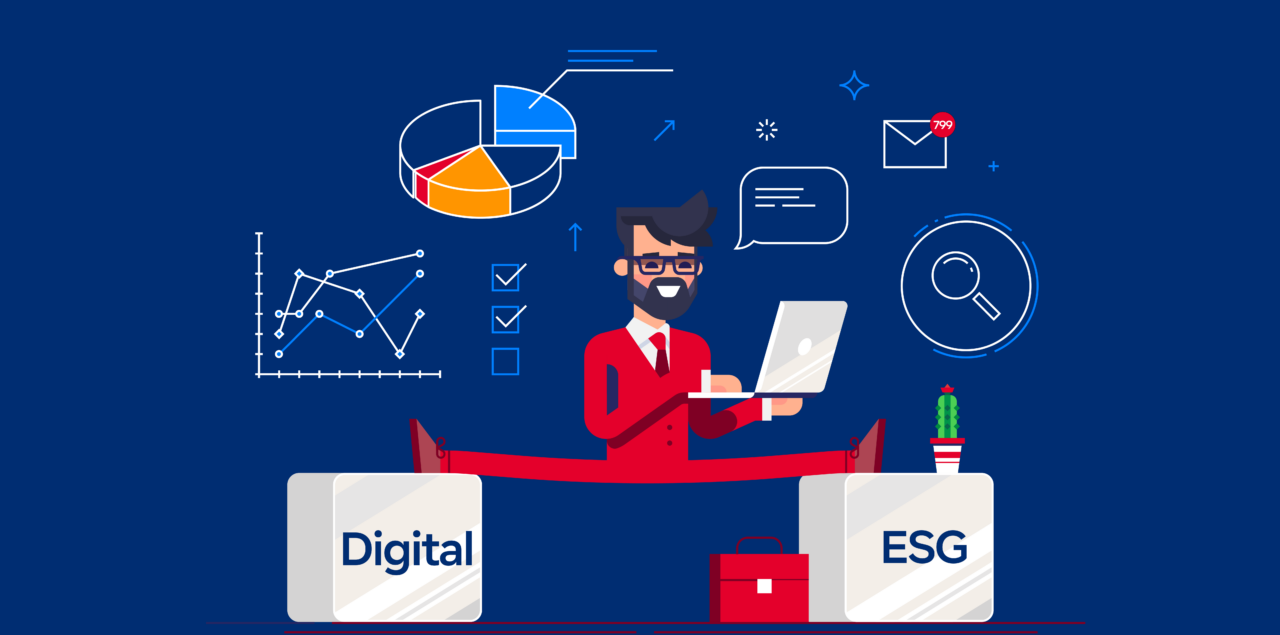
Sustainable insurance: How are insurers managing the balancing act between digitization and sustainability?
The insurance industry is in the midst of a digital transformation. Meanwhile, customers, the market and legislators are increasingly calling for a greater level of commitment to sustainability. This article explains how both areas can be implemented successfully by dovetailing digitization, data and ESG strategies.
EU taxonomy, disclosure regulation, CSRD… The growing number of regulatory ESG requirements means that insurers are increasingly having to grapple with the issue of sustainability. “From our project experience, we know that around 90% of insurers’ capacity is tied up. This is due to complying with industry-specific regulatory requirements, replacing legacy systems, and digitization initiatives. It would be an illusion to think that topics such as ESG could be covered by the remaining 10%. That would be a drop in the ocean,” says Dr. Markus Knapptisch, Executive Manager and insurance expert at Comma Soft, adding: “ESG, regulatory and digitalization can only be successfully implemented if they are considered in tandem right from the outset.”
Digital Insurance Podcast
How can insurers effectively address the issue of sustainability? Dr Markus Knappitsch and Dr Michael von Papen talked about this with Jonas Piela on the Digital Insurance Podcast.
You can listen to the complete episode here (in German).

Together with Dr. Michael von Papen, Lead Consultant Digital Sustainability at Comma Soft, Dr. Markus Knappitsch supports insurers on their journey to becoming sustainable, digital companies. “Insurers already have various levers at their disposal with which they can improve the sustainability of their business,” says Dr. Michael von Papen. According to the ESG expert, these levers include internal factors such as the vehicle fleet, IT and building use, which can help reduce Scope 1 and Scope 2 emissions. These are levers that every company possesses. They may think about asking themselves questions such as: Do we use offices or are our employees increasingly working from home? How is our paper consumption? Can we implement smart building control systems and use energy in a sustainable way? On the other hand, there are other external factors, including the type of investment, which are reflected in the Scope 3 range. “It is of crucial importance that the improvements achieved are measured and monitored. And this is where the dovetailing of the ESG strategy with the data and digitization strategy comes into its own,” explains Dr. Michael von Papen.
ESG transparency thanks to the data map
To meet ESG reporting obligations and, above all, to be able to identify one’s own sustainability potential, Dr. Markus Knappitsch recommends a clear data strategy: “When we support insurers in their digital transformation, a huge amount naturally revolves around data. Data are in the very DNA of insurers and form the basis of their core business. However, there is often a lack of clarity in cases where data is located in different departments, divisions and systems. One tool to create transparency here is the data map.” This visualization tool makes data and data streams visible, as well as data silos and bottlenecks in processes. This then provides a basis for developing a strategy for the more efficient use of data, the introduction of AI solutions and the optimization of processes. “ESG data, in particular, is frequently widely scattered across the company because it involves information from many different areas. This is where the data map can help provide an overview so that meaningful KPIs can be created. This is the basis for all further sustainability measures and reports,” adds Dr. Michael von Papen.
Navigating the data jungle: using data maps to unearth data treasures and make them accessible
Data provide insight, make progress measurable and accelerate processes – don’t they? In many a department, despite – or perhaps because of – the growing […]
Sustainable insurance products
If there is transparency with regard to the available data, this also helps in the concrete implementation of sustainable products. “Whether it’s underwriting risks, assessing investments or loss prevention: Data and AI help insurers make forecasts and take strategic decisions based on data. Up to now, the focus has often been on increasing cost efficiency and customer centricity as well as minimizing the regulatory risks. If ESG is a strategic goal, the sustainability aspect is added as another criterion. This allows products to be developed that both support the company’s internal sustainability goals and satisfy the wishes of customers and investors for sustainable products,” says Dr. Markus Knappitsch.
Bringing the ESG mindset into hearts, minds and processes
What else needs to be done to ensure that sustainability does not just remain a buzzword, but actually becomes something that is lived and practiced? In this regard, Dr. Michael von Papen considers the culture within the company to be the decisive factor: “ESG consists of three areas: environment, social and governance. Sustainable products and the reduction of emissions are often only aimed at the environmental aspect. However, internal guidelines – governance – and people who live sustainability on a daily basis also form a major part of it. And not because someone in management told them to, but because they see the added value themselves and they have the supporting framework in place.” In Dr. Michael von Papen’s experience, the change in people’s minds happens above all when employees are supported in their daily work: “If, for example, the input section is intelligently automated, this not only reduces paper consumption, it also creates a noticeable easing of the burden on employees. When actuaries leverage artificial intelligence (AI) wizards, they can identify sustainable investments but also risks to ESG goals without creating any additional work for themselves.”
Beyond an intrinsic motivation, there is also a necessity for appropriate skills. In the same way that staff are equipped for digitization through training, data literacy and ESG literacy can also be learned. “Besides motivation and having the skills, it is then also a matter of having confidence in the technology,” continues Dr. Markus Knappitsch. “How can employees and customers trust IT, data and artificial intelligence? In my experience, this trust is reinforced on the one hand through training in the relevant skills, because this creates a sense of security in dealing with them. On the other hand, transparency with regard to the innovations enhances trust. This transparency, in turn, can be created through data that demonstrates what has already been achieved through sustainability measures.”
What can insurers do now?
For insurance companies tackling the issue of sustainability, Dr. Markus Knappitsch and Dr. Michael von Papen offer the following tips:
1. Start small, but start!
Insurers ought to have a clear understanding of their strategic goal and then promptly implement small initiatives that work toward that goal. This brings about improvements more quickly and with a more manageable budget than a long strategy phase that is then implemented in a “big bang”.
2. Approach digitization and sustainability in a synergistic way
Digitization and sustainability are not at odds with each other, but go hand in hand when implemented in an integrative approach. This approach starts in the strategy phase and continues through the implementation of digitization and ESG measures – although ideally these no longer need to be differentiated at all.
3. Promote a culture of sustainability in the company
An open corporate culture that brings all employees on board and creates space for their ideas is more likely to lead to success than top-down approaches. This can be promoted, for example, through transparent communication, ESG literacy and targeted change & adoption formats.
4. Consider ESG in all three dimensions
ESG does not only stand for emission reduction, but also for its social and governance aspects. If all three of these aspects are considered and interlinked, this results in a more deeply rooted presence within the company – and a sustainability strategy that is effective in the long term.
5. Move away from the idea of a sustainability project
Sustainability is not just a one-off project that is completed within a few months. On the contrary, it is an ongoing process that ideally enters into the DNA of the company. It is therefore all the more important that appropriate measures can be implemented in day-to-day operations, see point 1: Start small – and keep on going!
Do you have any thoughts or questions about sustainability? Feel free to discuss them directly with our colleagues: you can get in touch with them here.

